ANALYSING THE PHYSICAL HEALTH STATUS
VerifiedAdded on 2022/08/17
|6
|1430
|14
AI Summary
Contribute Materials
Your contribution can guide someone’s learning journey. Share your
documents today.

Running head: PHYSICAL HEALTH STATUS/ANALYSIS
PHYSICAL HEALTH STATUS/ANALYSIS
Name of the student:
Name of university:
Author note:
PHYSICAL HEALTH STATUS/ANALYSIS
Name of the student:
Name of university:
Author note:
Secure Best Marks with AI Grader
Need help grading? Try our AI Grader for instant feedback on your assignments.
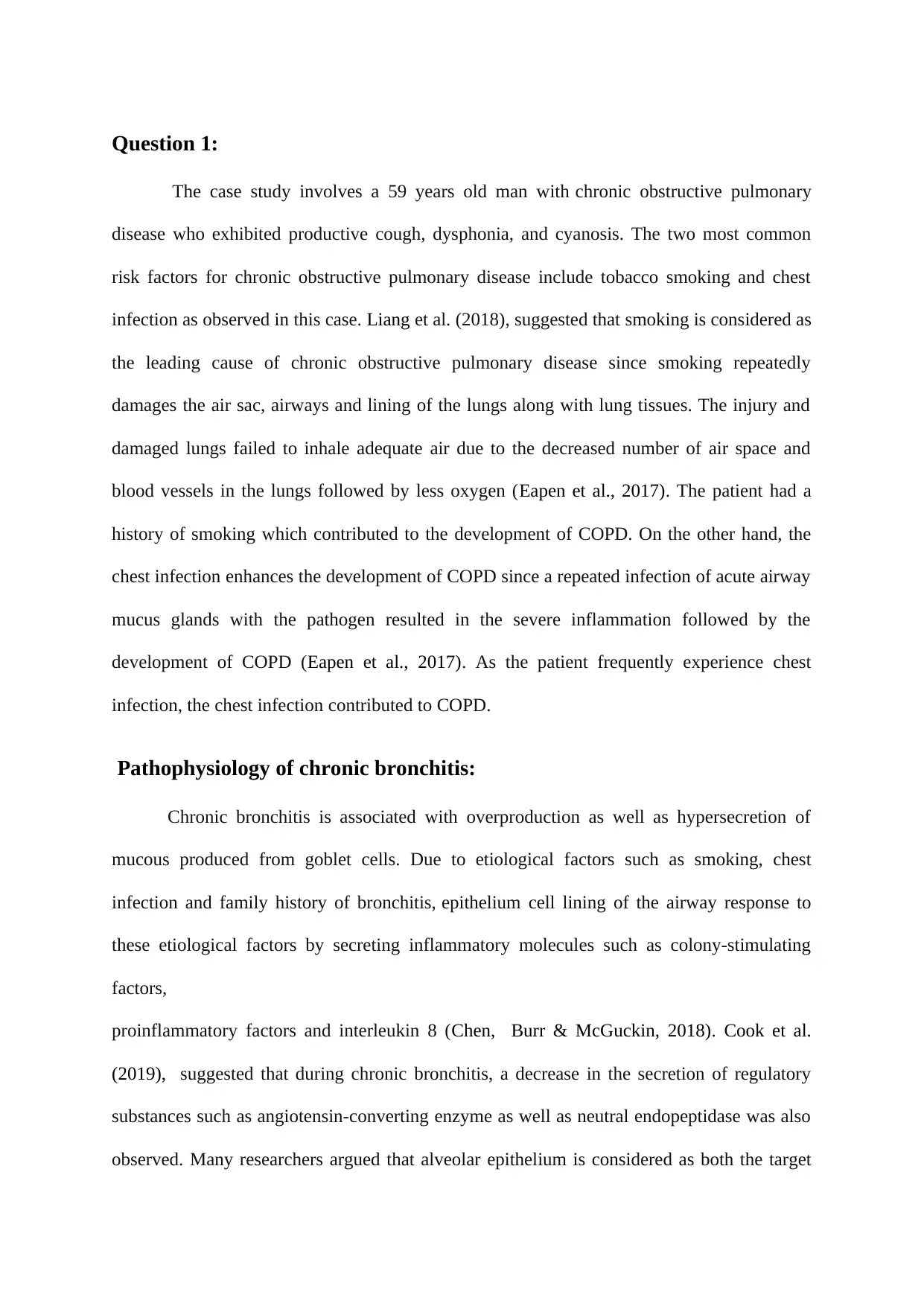
Question 1:
The case study involves a 59 years old man with chronic obstructive pulmonary
disease who exhibited productive cough, dysphonia, and cyanosis. The two most common
risk factors for chronic obstructive pulmonary disease include tobacco smoking and chest
infection as observed in this case. Liang et al. (2018), suggested that smoking is considered as
the leading cause of chronic obstructive pulmonary disease since smoking repeatedly
damages the air sac, airways and lining of the lungs along with lung tissues. The injury and
damaged lungs failed to inhale adequate air due to the decreased number of air space and
blood vessels in the lungs followed by less oxygen (Eapen et al., 2017). The patient had a
history of smoking which contributed to the development of COPD. On the other hand, the
chest infection enhances the development of COPD since a repeated infection of acute airway
mucus glands with the pathogen resulted in the severe inflammation followed by the
development of COPD (Eapen et al., 2017). As the patient frequently experience chest
infection, the chest infection contributed to COPD.
Pathophysiology of chronic bronchitis:
Chronic bronchitis is associated with overproduction as well as hypersecretion of
mucous produced from goblet cells. Due to etiological factors such as smoking, chest
infection and family history of bronchitis, epithelium cell lining of the airway response to
these etiological factors by secreting inflammatory molecules such as colony-stimulating
factors,
proinflammatory factors and interleukin 8 (Chen, Burr & McGuckin, 2018). Cook et al.
(2019), suggested that during chronic bronchitis, a decrease in the secretion of regulatory
substances such as angiotensin-converting enzyme as well as neutral endopeptidase was also
observed. Many researchers argued that alveolar epithelium is considered as both the target
The case study involves a 59 years old man with chronic obstructive pulmonary
disease who exhibited productive cough, dysphonia, and cyanosis. The two most common
risk factors for chronic obstructive pulmonary disease include tobacco smoking and chest
infection as observed in this case. Liang et al. (2018), suggested that smoking is considered as
the leading cause of chronic obstructive pulmonary disease since smoking repeatedly
damages the air sac, airways and lining of the lungs along with lung tissues. The injury and
damaged lungs failed to inhale adequate air due to the decreased number of air space and
blood vessels in the lungs followed by less oxygen (Eapen et al., 2017). The patient had a
history of smoking which contributed to the development of COPD. On the other hand, the
chest infection enhances the development of COPD since a repeated infection of acute airway
mucus glands with the pathogen resulted in the severe inflammation followed by the
development of COPD (Eapen et al., 2017). As the patient frequently experience chest
infection, the chest infection contributed to COPD.
Pathophysiology of chronic bronchitis:
Chronic bronchitis is associated with overproduction as well as hypersecretion of
mucous produced from goblet cells. Due to etiological factors such as smoking, chest
infection and family history of bronchitis, epithelium cell lining of the airway response to
these etiological factors by secreting inflammatory molecules such as colony-stimulating
factors,
proinflammatory factors and interleukin 8 (Chen, Burr & McGuckin, 2018). Cook et al.
(2019), suggested that during chronic bronchitis, a decrease in the secretion of regulatory
substances such as angiotensin-converting enzyme as well as neutral endopeptidase was also
observed. Many researchers argued that alveolar epithelium is considered as both the target
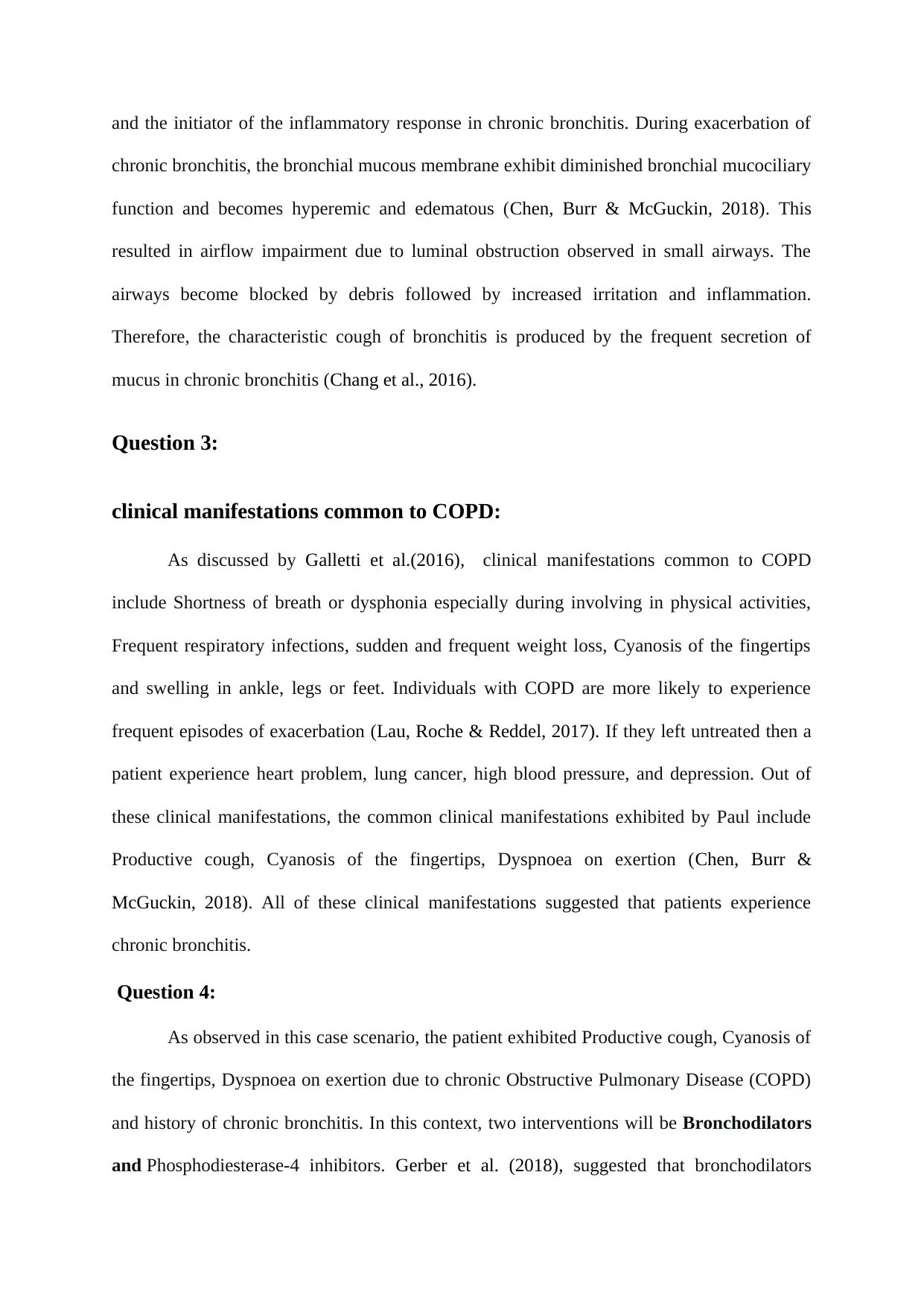
and the initiator of the inflammatory response in chronic bronchitis. During exacerbation of
chronic bronchitis, the bronchial mucous membrane exhibit diminished bronchial mucociliary
function and becomes hyperemic and edematous (Chen, Burr & McGuckin, 2018). This
resulted in airflow impairment due to luminal obstruction observed in small airways. The
airways become blocked by debris followed by increased irritation and inflammation.
Therefore, the characteristic cough of bronchitis is produced by the frequent secretion of
mucus in chronic bronchitis (Chang et al., 2016).
Question 3:
clinical manifestations common to COPD:
As discussed by Galletti et al.(2016), clinical manifestations common to COPD
include Shortness of breath or dysphonia especially during involving in physical activities,
Frequent respiratory infections, sudden and frequent weight loss, Cyanosis of the fingertips
and swelling in ankle, legs or feet. Individuals with COPD are more likely to experience
frequent episodes of exacerbation (Lau, Roche & Reddel, 2017). If they left untreated then a
patient experience heart problem, lung cancer, high blood pressure, and depression. Out of
these clinical manifestations, the common clinical manifestations exhibited by Paul include
Productive cough, Cyanosis of the fingertips, Dyspnoea on exertion (Chen, Burr &
McGuckin, 2018). All of these clinical manifestations suggested that patients experience
chronic bronchitis.
Question 4:
As observed in this case scenario, the patient exhibited Productive cough, Cyanosis of
the fingertips, Dyspnoea on exertion due to chronic Obstructive Pulmonary Disease (COPD)
and history of chronic bronchitis. In this context, two interventions will be Bronchodilators
and Phosphodiesterase-4 inhibitors. Gerber et al. (2018), suggested that bronchodilators
chronic bronchitis, the bronchial mucous membrane exhibit diminished bronchial mucociliary
function and becomes hyperemic and edematous (Chen, Burr & McGuckin, 2018). This
resulted in airflow impairment due to luminal obstruction observed in small airways. The
airways become blocked by debris followed by increased irritation and inflammation.
Therefore, the characteristic cough of bronchitis is produced by the frequent secretion of
mucus in chronic bronchitis (Chang et al., 2016).
Question 3:
clinical manifestations common to COPD:
As discussed by Galletti et al.(2016), clinical manifestations common to COPD
include Shortness of breath or dysphonia especially during involving in physical activities,
Frequent respiratory infections, sudden and frequent weight loss, Cyanosis of the fingertips
and swelling in ankle, legs or feet. Individuals with COPD are more likely to experience
frequent episodes of exacerbation (Lau, Roche & Reddel, 2017). If they left untreated then a
patient experience heart problem, lung cancer, high blood pressure, and depression. Out of
these clinical manifestations, the common clinical manifestations exhibited by Paul include
Productive cough, Cyanosis of the fingertips, Dyspnoea on exertion (Chen, Burr &
McGuckin, 2018). All of these clinical manifestations suggested that patients experience
chronic bronchitis.
Question 4:
As observed in this case scenario, the patient exhibited Productive cough, Cyanosis of
the fingertips, Dyspnoea on exertion due to chronic Obstructive Pulmonary Disease (COPD)
and history of chronic bronchitis. In this context, two interventions will be Bronchodilators
and Phosphodiesterase-4 inhibitors. Gerber et al. (2018), suggested that bronchodilators
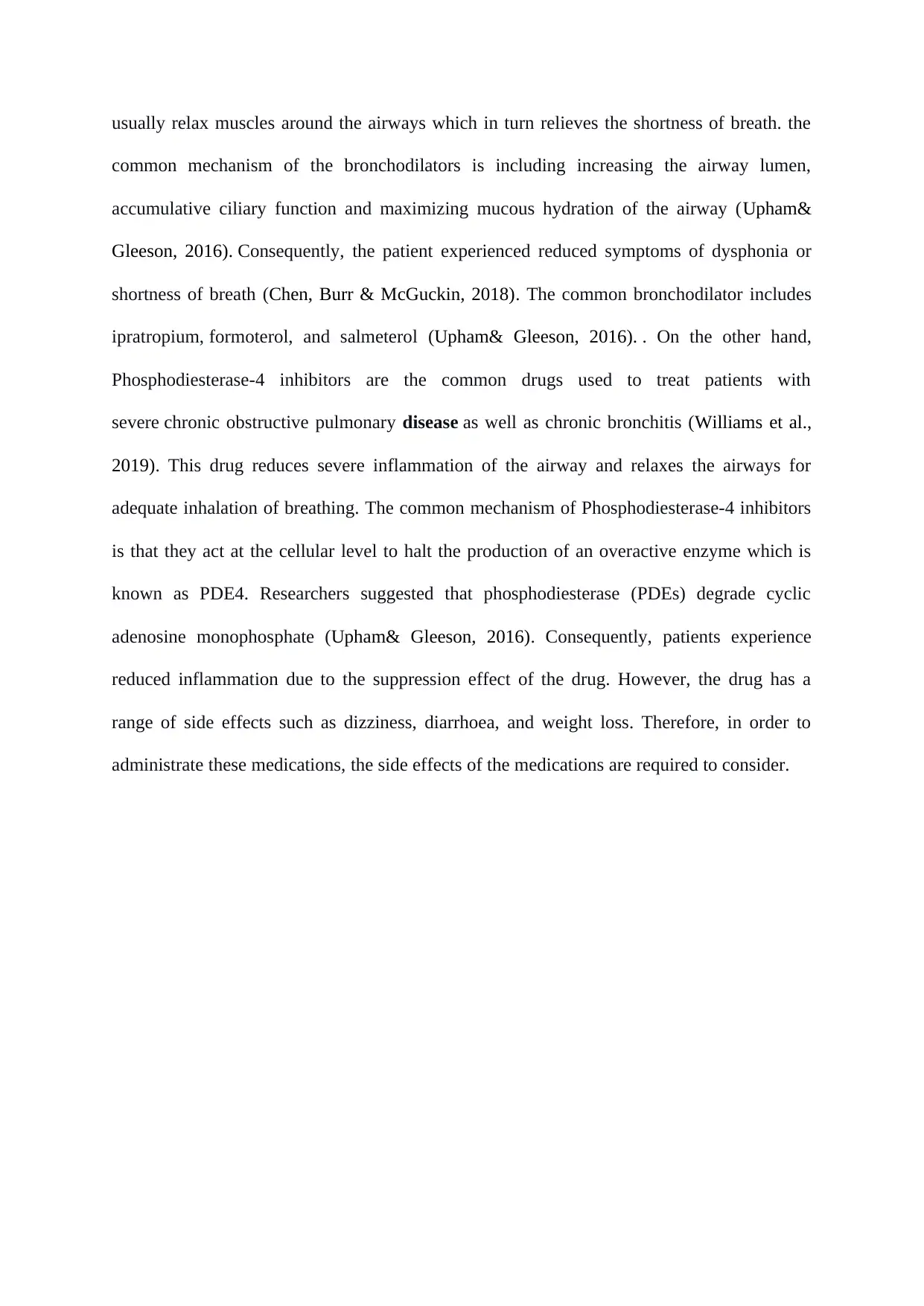
usually relax muscles around the airways which in turn relieves the shortness of breath. the
common mechanism of the bronchodilators is including increasing the airway lumen,
accumulative ciliary function and maximizing mucous hydration of the airway (Upham&
Gleeson, 2016). Consequently, the patient experienced reduced symptoms of dysphonia or
shortness of breath (Chen, Burr & McGuckin, 2018). The common bronchodilator includes
ipratropium, formoterol, and salmeterol (Upham& Gleeson, 2016). . On the other hand,
Phosphodiesterase-4 inhibitors are the common drugs used to treat patients with
severe chronic obstructive pulmonary disease as well as chronic bronchitis (Williams et al.,
2019). This drug reduces severe inflammation of the airway and relaxes the airways for
adequate inhalation of breathing. The common mechanism of Phosphodiesterase-4 inhibitors
is that they act at the cellular level to halt the production of an overactive enzyme which is
known as PDE4. Researchers suggested that phosphodiesterase (PDEs) degrade cyclic
adenosine monophosphate (Upham& Gleeson, 2016). Consequently, patients experience
reduced inflammation due to the suppression effect of the drug. However, the drug has a
range of side effects such as dizziness, diarrhoea, and weight loss. Therefore, in order to
administrate these medications, the side effects of the medications are required to consider.
common mechanism of the bronchodilators is including increasing the airway lumen,
accumulative ciliary function and maximizing mucous hydration of the airway (Upham&
Gleeson, 2016). Consequently, the patient experienced reduced symptoms of dysphonia or
shortness of breath (Chen, Burr & McGuckin, 2018). The common bronchodilator includes
ipratropium, formoterol, and salmeterol (Upham& Gleeson, 2016). . On the other hand,
Phosphodiesterase-4 inhibitors are the common drugs used to treat patients with
severe chronic obstructive pulmonary disease as well as chronic bronchitis (Williams et al.,
2019). This drug reduces severe inflammation of the airway and relaxes the airways for
adequate inhalation of breathing. The common mechanism of Phosphodiesterase-4 inhibitors
is that they act at the cellular level to halt the production of an overactive enzyme which is
known as PDE4. Researchers suggested that phosphodiesterase (PDEs) degrade cyclic
adenosine monophosphate (Upham& Gleeson, 2016). Consequently, patients experience
reduced inflammation due to the suppression effect of the drug. However, the drug has a
range of side effects such as dizziness, diarrhoea, and weight loss. Therefore, in order to
administrate these medications, the side effects of the medications are required to consider.
Secure Best Marks with AI Grader
Need help grading? Try our AI Grader for instant feedback on your assignments.
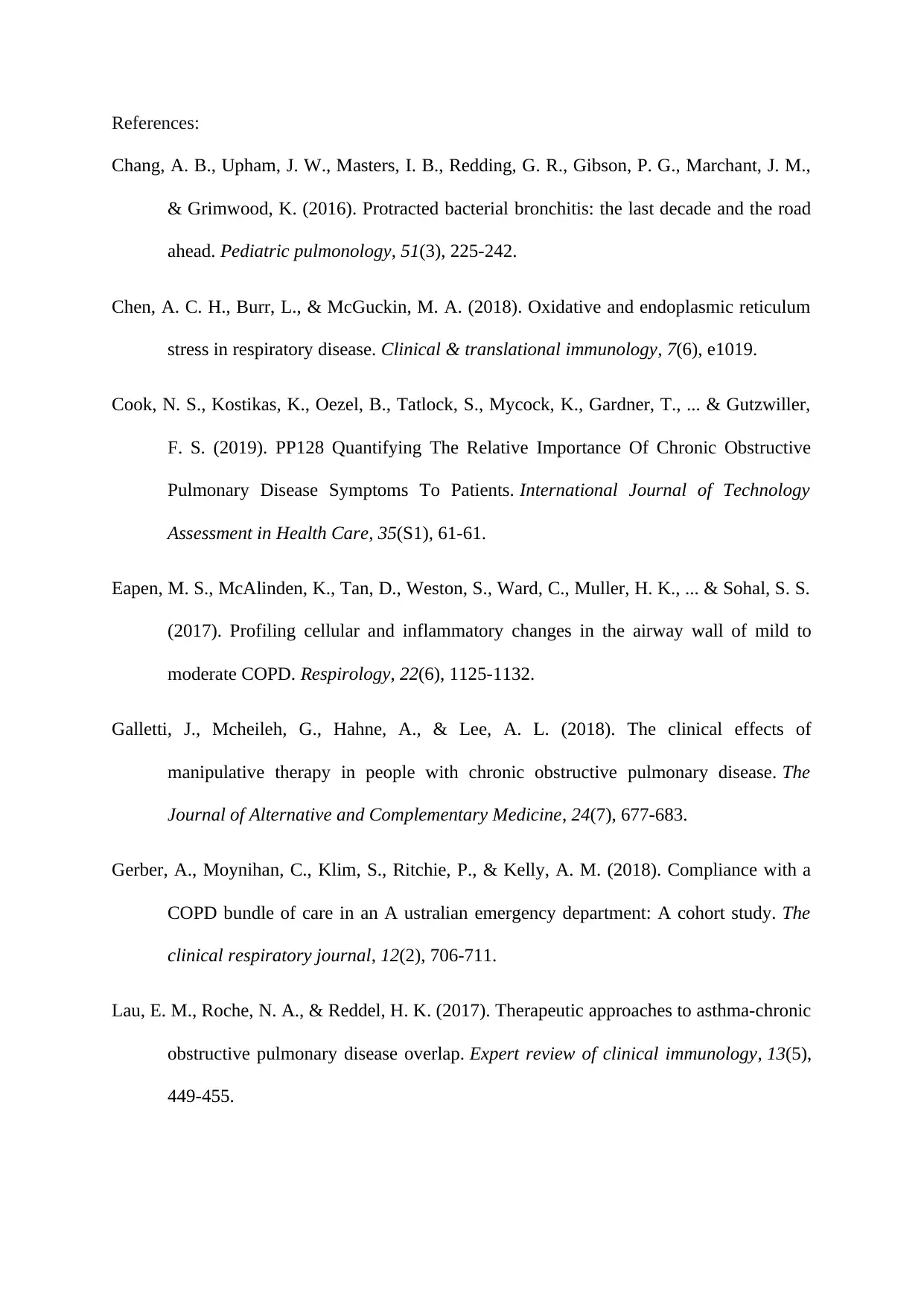
References:
Chang, A. B., Upham, J. W., Masters, I. B., Redding, G. R., Gibson, P. G., Marchant, J. M.,
& Grimwood, K. (2016). Protracted bacterial bronchitis: the last decade and the road
ahead. Pediatric pulmonology, 51(3), 225-242.
Chen, A. C. H., Burr, L., & McGuckin, M. A. (2018). Oxidative and endoplasmic reticulum
stress in respiratory disease. Clinical & translational immunology, 7(6), e1019.
Cook, N. S., Kostikas, K., Oezel, B., Tatlock, S., Mycock, K., Gardner, T., ... & Gutzwiller,
F. S. (2019). PP128 Quantifying The Relative Importance Of Chronic Obstructive
Pulmonary Disease Symptoms To Patients. International Journal of Technology
Assessment in Health Care, 35(S1), 61-61.
Eapen, M. S., McAlinden, K., Tan, D., Weston, S., Ward, C., Muller, H. K., ... & Sohal, S. S.
(2017). Profiling cellular and inflammatory changes in the airway wall of mild to
moderate COPD. Respirology, 22(6), 1125-1132.
Galletti, J., Mcheileh, G., Hahne, A., & Lee, A. L. (2018). The clinical effects of
manipulative therapy in people with chronic obstructive pulmonary disease. The
Journal of Alternative and Complementary Medicine, 24(7), 677-683.
Gerber, A., Moynihan, C., Klim, S., Ritchie, P., & Kelly, A. M. (2018). Compliance with a
COPD bundle of care in an A ustralian emergency department: A cohort study. The
clinical respiratory journal, 12(2), 706-711.
Lau, E. M., Roche, N. A., & Reddel, H. K. (2017). Therapeutic approaches to asthma-chronic
obstructive pulmonary disease overlap. Expert review of clinical immunology, 13(5),
449-455.
Chang, A. B., Upham, J. W., Masters, I. B., Redding, G. R., Gibson, P. G., Marchant, J. M.,
& Grimwood, K. (2016). Protracted bacterial bronchitis: the last decade and the road
ahead. Pediatric pulmonology, 51(3), 225-242.
Chen, A. C. H., Burr, L., & McGuckin, M. A. (2018). Oxidative and endoplasmic reticulum
stress in respiratory disease. Clinical & translational immunology, 7(6), e1019.
Cook, N. S., Kostikas, K., Oezel, B., Tatlock, S., Mycock, K., Gardner, T., ... & Gutzwiller,
F. S. (2019). PP128 Quantifying The Relative Importance Of Chronic Obstructive
Pulmonary Disease Symptoms To Patients. International Journal of Technology
Assessment in Health Care, 35(S1), 61-61.
Eapen, M. S., McAlinden, K., Tan, D., Weston, S., Ward, C., Muller, H. K., ... & Sohal, S. S.
(2017). Profiling cellular and inflammatory changes in the airway wall of mild to
moderate COPD. Respirology, 22(6), 1125-1132.
Galletti, J., Mcheileh, G., Hahne, A., & Lee, A. L. (2018). The clinical effects of
manipulative therapy in people with chronic obstructive pulmonary disease. The
Journal of Alternative and Complementary Medicine, 24(7), 677-683.
Gerber, A., Moynihan, C., Klim, S., Ritchie, P., & Kelly, A. M. (2018). Compliance with a
COPD bundle of care in an A ustralian emergency department: A cohort study. The
clinical respiratory journal, 12(2), 706-711.
Lau, E. M., Roche, N. A., & Reddel, H. K. (2017). Therapeutic approaches to asthma-chronic
obstructive pulmonary disease overlap. Expert review of clinical immunology, 13(5),
449-455.
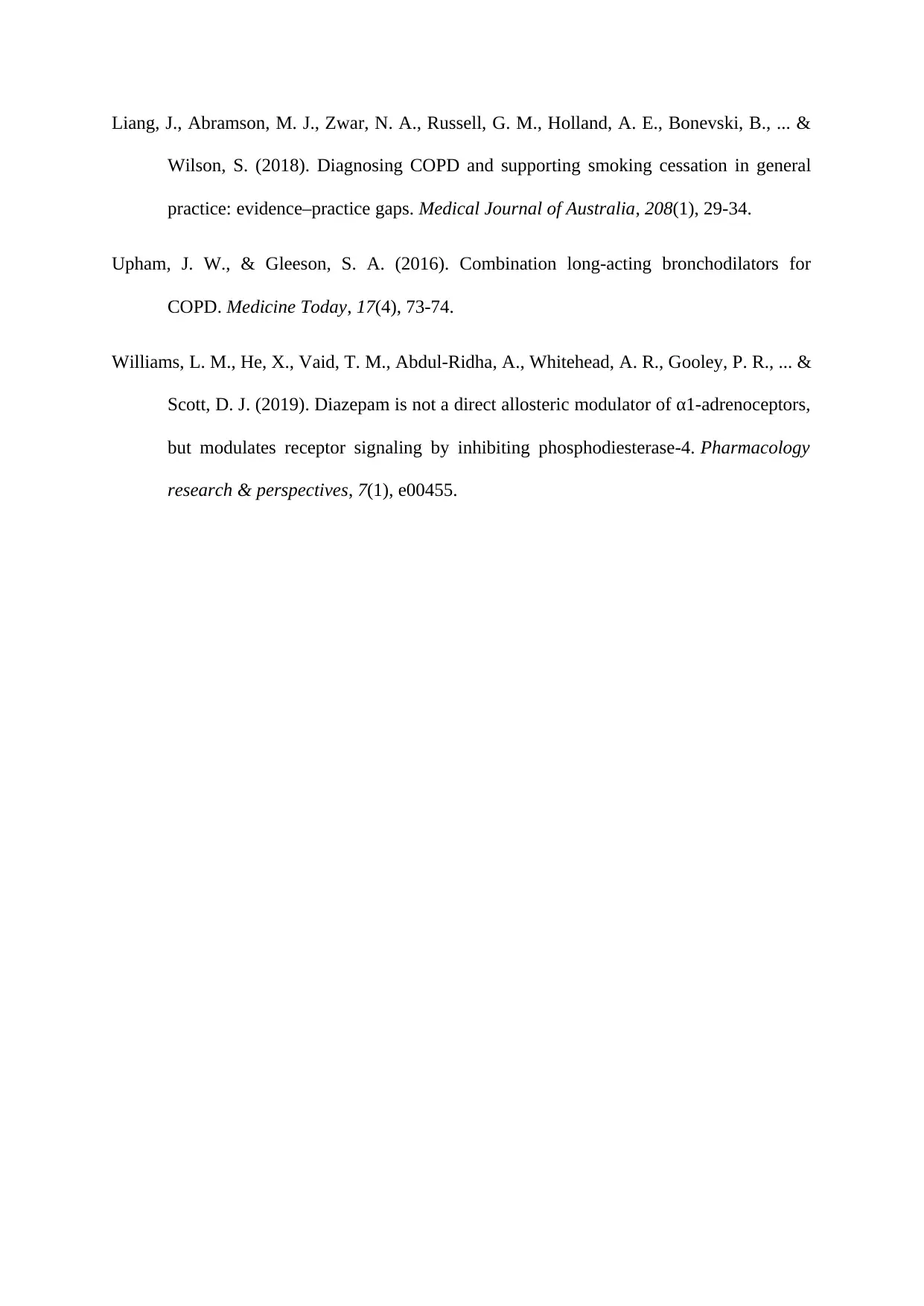
Liang, J., Abramson, M. J., Zwar, N. A., Russell, G. M., Holland, A. E., Bonevski, B., ... &
Wilson, S. (2018). Diagnosing COPD and supporting smoking cessation in general
practice: evidence–practice gaps. Medical Journal of Australia, 208(1), 29-34.
Upham, J. W., & Gleeson, S. A. (2016). Combination long-acting bronchodilators for
COPD. Medicine Today, 17(4), 73-74.
Williams, L. M., He, X., Vaid, T. M., Abdul‐Ridha, A., Whitehead, A. R., Gooley, P. R., ... &
Scott, D. J. (2019). Diazepam is not a direct allosteric modulator of α1‐adrenoceptors,
but modulates receptor signaling by inhibiting phosphodiesterase‐4. Pharmacology
research & perspectives, 7(1), e00455.
Wilson, S. (2018). Diagnosing COPD and supporting smoking cessation in general
practice: evidence–practice gaps. Medical Journal of Australia, 208(1), 29-34.
Upham, J. W., & Gleeson, S. A. (2016). Combination long-acting bronchodilators for
COPD. Medicine Today, 17(4), 73-74.
Williams, L. M., He, X., Vaid, T. M., Abdul‐Ridha, A., Whitehead, A. R., Gooley, P. R., ... &
Scott, D. J. (2019). Diazepam is not a direct allosteric modulator of α1‐adrenoceptors,
but modulates receptor signaling by inhibiting phosphodiesterase‐4. Pharmacology
research & perspectives, 7(1), e00455.
1 out of 6
Related Documents
Your All-in-One AI-Powered Toolkit for Academic Success.
+13062052269
info@desklib.com
Available 24*7 on WhatsApp / Email
![[object Object]](/_next/static/media/star-bottom.7253800d.svg)
Unlock your academic potential
© 2024 | Zucol Services PVT LTD | All rights reserved.




